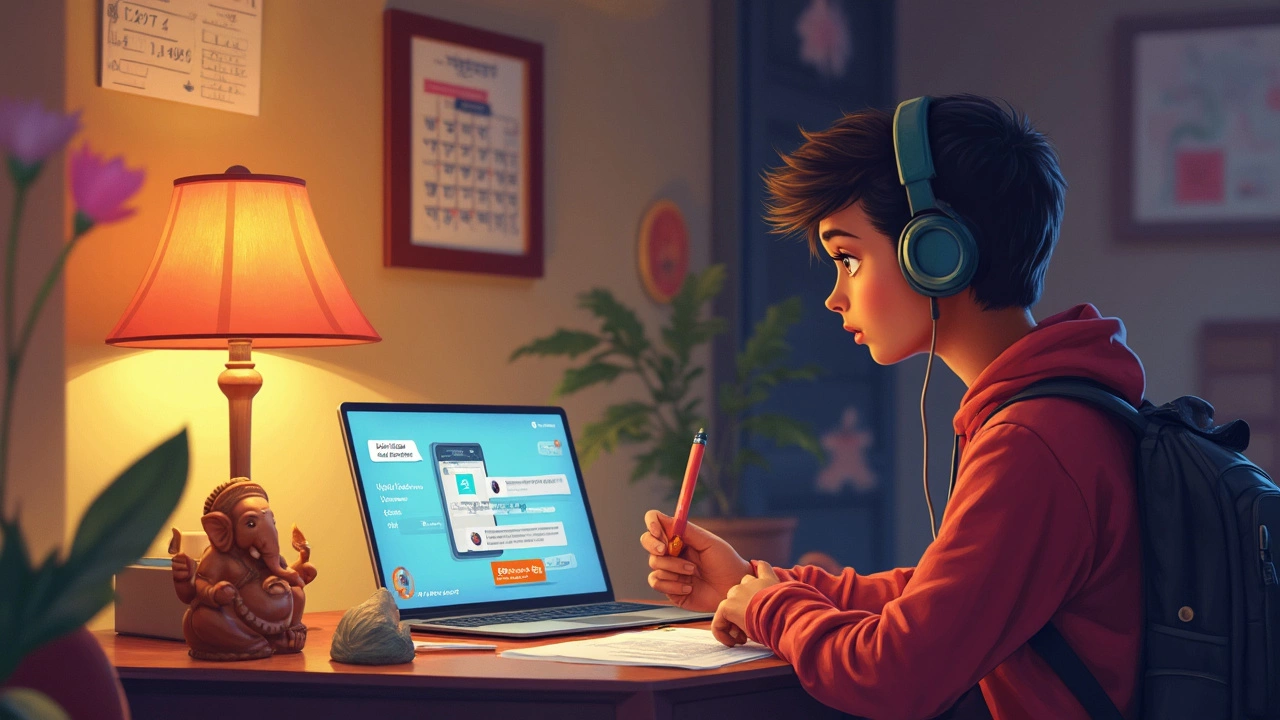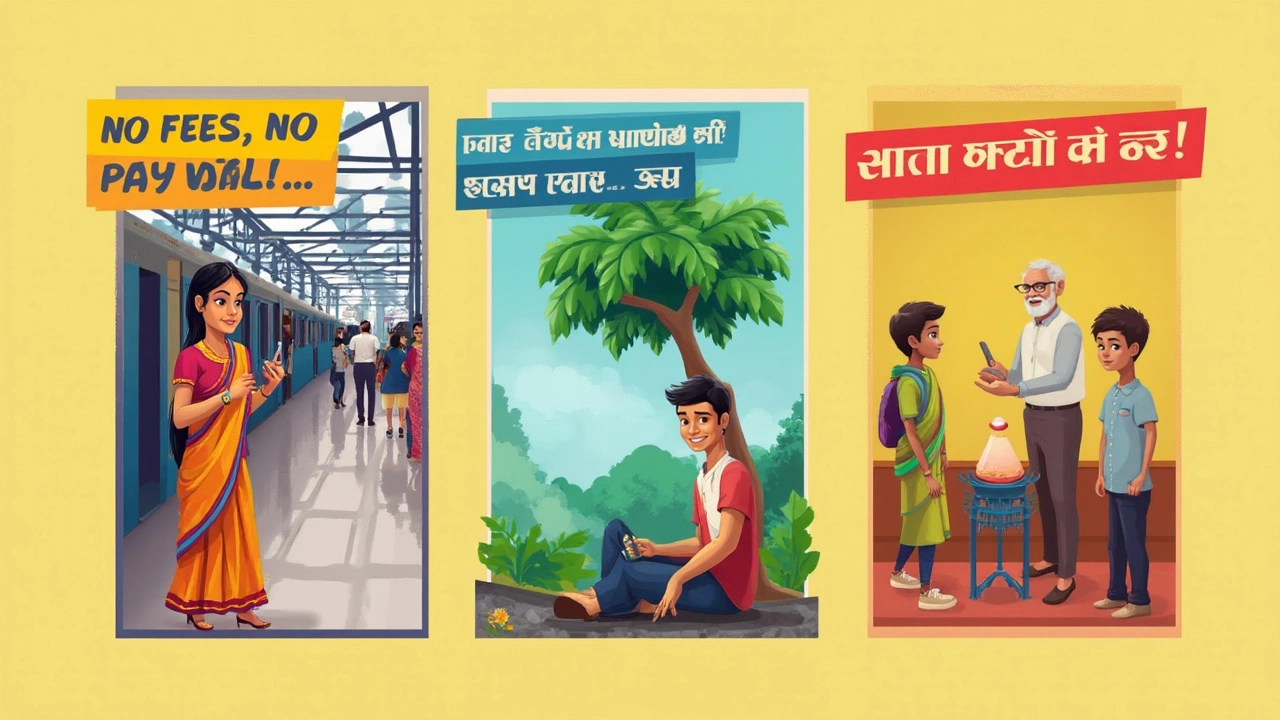
Ever searched for a free educational app and felt tricked by hidden costs? You're not alone. Tons of apps claim to be free, but after you sign up, they start showing 'premium' features or slap on a paywall for the best content. It gets frustrating, especially when you just want to learn without pulling out your wallet.
The good news? There are real, 100% free options that don’t charge for basic courses, certificates, or limit how much you can study. But finding these gems can feel like hunting for treasure if you don’t know where to look. This article cuts through all the marketing noise and gives you a straight answer: which apps are the real deal, and which ones just talk the talk.
You’ll also get quick tips on avoiding the common traps—like sudden ads, sneaky upsells, and disappearing free trials. If you’re in school, upskilling at work, or just trying to learn something new for fun, knowing which app is truly free saves your time and your sanity. No academic jargon. Just what’s worth installing on your phone or laptop today.
- Hunting for True Freebies: How Most Educational Apps Work
- Standout Picks: Apps That Are Actually Free
- Hidden Catches: Is 'Free' Ever Really Free?
- Top Tips to Use Free E-Learning Apps Smartly
- Making the Most Out of Totally Free Learning
Hunting for True Freebies: How Most Educational Apps Work
The hunt for a legit free learning app can feel like shopping in a tricky street market. Everyone’s shouting 'free!' but most stick a price tag on the best stuff. Understanding how these free educational apps make money helps you spot the real deals.
Most e-learning platforms follow one of these models:
- Freemium: The app lets you in for free but blocks cool features, like quizzes, certificates, or top courses, unless you pay. Apps like Duolingo, for example, let users learn languages for free but push paid subscriptions for an ad-free experience and extras.
- Trial Periods: Some let you try everything for a week or two before asking for cash. Coursera often works this way—many courses are free to audit, but graded assignments and certificates usually need payment.
- Paywall on Content: Basics are free, but deep-dive content costs money. Think of Khan Academy kids’ app, which lets you use basic content for free but charges for full access to premium stuff.
- Truly Free: A small club. These platforms offer quality content with no sneaky fees or promotions. They’re funded by grants, donors, or government support instead of user payments. The best-known examples are Khan Academy and Allversity.
Here's a snapshot of how major platforms stack up on the real "totally free" question:
| App Name | Completely Free? | Any Limitations? |
|---|---|---|
| Khan Academy | Yes | No—full content and certificates are free |
| Udemy | No | Most courses require payment; only a few are free |
| Coursera | Partially | Audit for free, pay for graded work/certificates |
| Duolingo | Mostly | Free core experience, ads, premium extras locked |
| Allversity | Yes | Some subjects less in-depth |
So if you’re tired of bait-and-switch, search for "open access," "non-profit," or "donor-based" in the app listing. That usually means no hidden fees. If an app pushes you for your card or wink-winks at "premium," you’re probably not getting the full free ride.
Standout Picks: Apps That Are Actually Free
Finding an educational app that’s totally free—no in-app purchases, no ads for extra content, no surprise fees—is surprisingly tough these days. But there are a few platforms that actually mean it when they say “free.” You don’t need to enter your credit card or set reminders to cancel a trial. Here are some of the strongest picks if you want a free educational app that delivers real value.
- Khan Academy – This is the OG of free learning apps. Khan Academy is genuinely free from start to finish. You can learn math, science, history, economics and more. There are no premium tiers. Want to learn Algebra, prep for SATs, or explore basic finance? Their app covers it all, and you even get practice questions plus instant feedback.
- Duolingo – Maybe you’ve seen the green owl meme. Duolingo is free for language learners. While they do have a paid “Super Duolingo” for extras, their core lessons are fully open—no lessons locked, and you can practice as much as you want. Over 100 million downloads and lots of schools use it too.
- GCFLearnFree.org – Less popular but super practical. GCFLearnFree’s app and website offer courses on computer basics, email, Microsoft Office, math, reading, and career skills. No registration, no cost. If you need to brush up on MS Excel or typing, start here.
- Coursera (free courses only) – Lots of folks think Coursera is only paid, but you can audit a bunch of top courses for free by choosing the “audit” option instead of “enroll for certificate.” Yes, certificates are paid, but you still get all videos and quizzes totally free.
- TED – TED’s official app puts thousands of inspiring talks in your hands. Free to watch, save, or share. Perfect for quick learning—videos are bite-sized and cover a massive range of topics from science to motivation.
- National Digital Library of India (NDLI) – Especially handy for Indian students, NDLI gathers textbooks, lectures, exam prep, and reference material—completely open and free, from classes 1 through post-grad.
Take a look at this quick stats table to compare what’s really free on each app:
| App Name | Main Subjects | Ads | Paid Upgrades? | Certificates |
|---|---|---|---|---|
| Khan Academy | Math, Science, Arts, More | No | No | Yes (all free) |
| Duolingo | Languages (40+) | Some (short) | Yes (optional) | No |
| GCFLearnFree | Digital Skills, Life Skills | No | No | No |
| Coursera (audit mode) | University Topics | No | Yes (for certificates) | Paid |
| TED | Talks (varied) | No | No | No |
| NDLI | Academic Subjects | No | No | No |
It’s smart to check what’s really included before you download. If you care about getting a free certificate, Khan Academy is your best bet. For language learning that actually sticks, Duolingo’s still at the top. Need tech skills or office know-how for work? GCFLearnFree is about as hassle-free as it gets. Download a couple, see which vibe you like, and get learning without ever worrying about a monthly bill popping up later.

Hidden Catches: Is 'Free' Ever Really Free?
Let's be honest—when you come across a supposedly free educational app, your guard goes up. There's usually some kind of catch, right? Sadly, that's true more often than anyone wants to admit. Most e-learning apps use a 'freemium' model. That means they hook you with a bit of content for nothing and then ask for payment if you want the juicy stuff—like advanced lessons, certificates, or ad-free studying.
A concrete example is Coursera. You can access plenty of course videos for free, but if you want official certificates or graded assignments, you need to pay. Khan Academy, on the other hand, really is free—no premium tier, no sneaky unlocks, and no credit card required. It’s funded by donations and trusted worldwide for school-level content.
Here are some things to watch out for when trying to spot the real deal versus an app with surprises:
- Paywalls after registration: Some apps let you browse for free, but when you sign up, they limit access unless you subscribe.
- Certificate fees: You study all the material but then find out certificates cost extra—common on platforms like edX and Alison.
- Ads and distractions: Apps may be free because of obnoxious ads that pop up as you learn. Sometimes the ads are so frequent, it kills your focus.
- Hidden limits: A few apps quietly cap the number of courses you can take or restrict your daily learning time unless you upgrade.
- Data collection: Some ask for tons of personal info to use 'free' features, so your data pays for your learning instead of your money.
Bottom line: double-check the details before you get invested. Read user reviews, dig through FAQ pages, and try a few lessons to see exactly what’s offered for free. If you don’t see a clear “100% free” promise (like on Khan Academy or the MIT OpenCourseWare site), chances are they’ll ask for something sooner or later. That way, you can spend your time learning instead of wrestling with surprise paywalls.
Top Tips to Use Free E-Learning Apps Smartly
If you want to get the most out of free educational apps, you can’t just install them and hope magic happens. You need to know a few tricks or you’ll miss out on the good stuff. Here’s what actually works.
- Stick to official platforms. Always download apps from the official Play Store, App Store, or the main website. This keeps you safe from fake versions loaded with ads or scams.
- Sign up with your email, not Google or Facebook, when you can. A lot of free apps give bonus points, exclusive lessons, or early updates if you register directly.
- Use the search and filter functions. Big platforms like Khan Academy and Coursera have thousands of lessons. Filters save you from endless scrolling—search for the exact topic, grade, or skill you want.
- Switch notification alerts on for reminders, but switch off promotional popups. Most apps let you choose which notifications you actually want, so you’ll get nudged to study but won’t be bothered by sales pitches.
- Keep an eye on community features. Many free e-learning apps have active forums or discussion boards. These can be goldmines for quick answers, cheat-sheets, or even peer tutoring.
If you’re juggling school work or upskilling at your job, this matters: free doesn’t mean low-quality.
"There’s a lot of research showing that free courses can deliver as much learning as paid ones, especially when learners stay engaged and use the extra resources available," — EdSurge, 2023.
And here’s a bonus move—download course materials for offline use if the app allows it. Not every app offers this, but it’s a lifesaver when the Wi-Fi cuts out or you’re on a slow connection.
Bottom line: treat these free educational apps like a buffet. Take what you need, try new topics, and make use of every tool built into the platform. You don’t have to spend money to get smarter—you just have to use what’s there, the right way.

Making the Most Out of Totally Free Learning
Jumping into free educational apps is easy, but getting solid results takes a little effort. You’ll find that these apps open the door for self-paced learning, but you want to avoid falling into the trap of starting ten courses and finishing none. The big win comes from using these tools with focus and consistency.
Here’s how you can squeeze the most out of free resources without getting overwhelmed or bored:
- Pick one goal at a time: Instead of trying everything, set a simple goal—like clearing a math topic or building basic coding skills. This helps you stay motivated.
- Make a short schedule: Even 20 minutes a day adds up. Apps like Khan Academy let you track your daily streaks which makes sticking to your plan way easier.
- Use app features fully: Take quizzes, try interactive lessons, and don’t ignore discussion forums. These features keep things interesting and help stuff stick in your head.
- Connect with others: Many apps, like Coursera or Udemy, have student groups and communities—so you can ask questions, find help, or just stay upbeat.
- Grab the certificates: Some platforms, including Alison and Saylor Academy, offer no-cost certificates for completed courses. These come in handy for job hunting or college applications.
It helps to know where other learners make mistakes. Based on a 2024 student survey run by Class Central, here’s what trips people up the most and what actually works:
| Common Roadblock | Best Fix |
|---|---|
| Procrastination | Set small daily reminders in the app |
| Losing Interest | Mix subjects, add interactive tasks |
| Getting Stuck | Ask questions, use forums or study groups |
| Forgetfulness | Take digital notes, make summaries regularly |
Free apps can be goldmines if you treat them like the real deal. Check for the latest updates or new features every couple of months, as most platforms roll out fresh lessons and even new subjects for users who stick around. And don’t forget to take those certificates and add them to your LinkedIn—or even your CV—because free learning can still open doors if you show what you’ve achieved.
